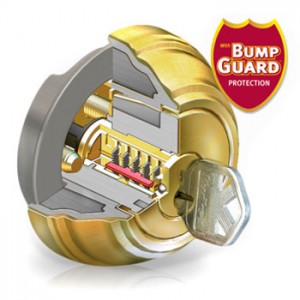Upgrade Your Residential Locks to High-Security Bump-Proof Locks
 Worried about thieves with bump keys breaking into your property? RBM Lock & Key can help.
Worried about thieves with bump keys breaking into your property? RBM Lock & Key can help.
Many types of locks can be picked extremely easily using bump keys. If you want to improve the security of your home, have a professional from RBM Lock & Key come out to your property to evaluate your current locks and suggest possible upgrades.
What is a Bump-Proof Lock?
A bump-proof lock is any type of lock with features that make it invulnerable to lockpicking using a bump key. A bump key is basically a key blank that has been filed into a standardized key form featuring a bump for every pin in a typical spring-loaded pin tumbler style lock. When the bump key is shoved into the lock, it causes the individual pin tumblers to temporarily align and if the key is turned quickly enough, the lock will open. Some examples of bump-proof locks include disc tumbler locks, which have discs instead of pins, and trap pin locks, which feature pins that lock into place when not supported by a pin to jam the cylinder. Shallow drilled locks can also protect against bump keys by making one or more pins too high for the bump key to reach.
Magnetic Keys
Magnetic locks are very interesting and can provide excellent protection against bump keys as well as against traditional lockpicking and key duplication methods. The keys for magnetic locks contain one or more small magnets, which are oriented in such a way that the magnets’ poles will push or pull against magnets in corresponding locations inside the lock mechanism in order to open the lock. The more magnets used, the more possible combinations of placement and polarity and the tougher the lock will be to crack.
Consider Electronic Locks
Electronic locks offer a compelling alternative to traditional locks for many reasons. Keyless systems are quite convenient, as well as more secure because there is no key to lose or to duplicate. That said, watch out for keyless systems whose emergency manual component is a pin tumbler lock, as a thief could potentially use a bump key on this part of the system.
Don’t Forget the Strike Plate
Kicking the door in may not be the most elegant way of breaking into a home or business, but it is undeniably effective. Even a high-security lock can be vulnerable to this approach if it is not supported by the right hardware. Most locks come with a flimsy strike plate and short screws to anchor it in the door jamb. By replacing the standard plate with a high-security box strike and replacing the short mounting screws with ones up to 3 inches long, you can significantly increase the security and protection offered by any type of lock.

 909-980-3448
909-980-3448




 Worried about thieves with bump keys breaking into your property? RBM Lock & Key can help.
Worried about thieves with bump keys breaking into your property? RBM Lock & Key can help.




 2235 E. 4th St Suite B, Ontario, CA 91764
2235 E. 4th St Suite B, Ontario, CA 91764